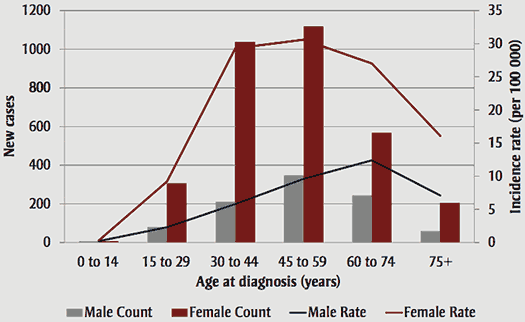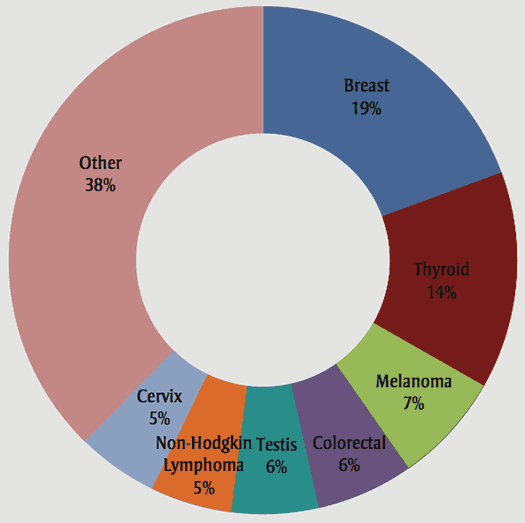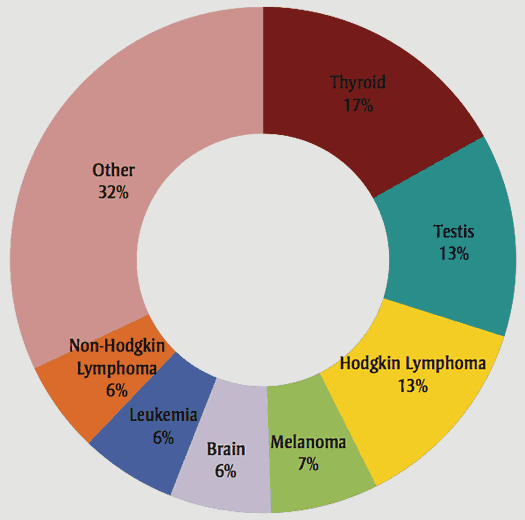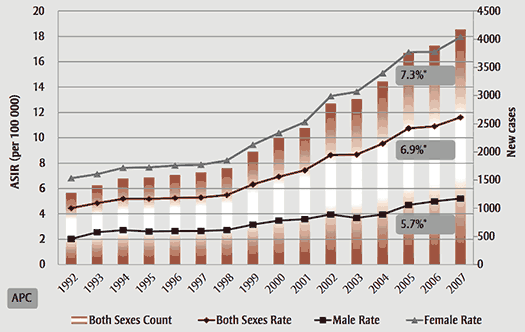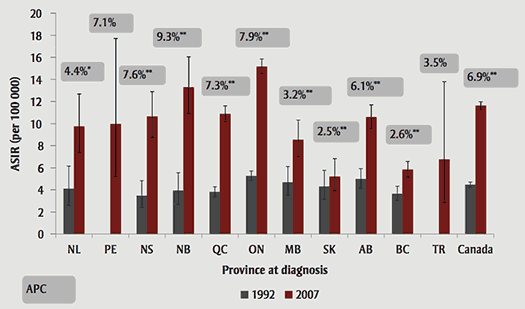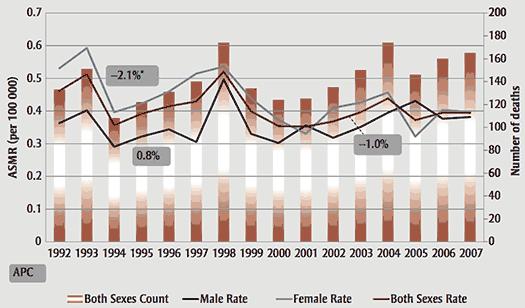Cancer in Canada Fact Sheet Series #1
Thyroid cancer in Canada
A. Shaw, MSc; R. Semenciw, MSc; L. Mery, MSc
https://doi.org/10.24095/hpcdp.34.1.09
This article has been peer reviewed.
Author references:
Chronic Disease Surveillance and Monitoring Division, Centre for Chronic Disease Prevention, Public Health Agency of Canada
Correspondence: Amanda Shaw, Chronic Disease Surveillance and Monitoring Division, Centre for Chronic Disease Prevention, Public Health Agency of Canada, 785 Carling Avenue, Ottawa, ON K1A 0K9; Tel.: 613-941-6464; Fax: 613-941-2057; Email: amanda.shaw@phac-aspc.gc.ca
- The incidence of thyroid cancer is increasing more rapidly than that of any other cancer in Canada, while mortality has remained low and stable
- In the last 10 years the number of thyroid cancer cases has increased 144% from 1709 to 4172 cases per year
- Thyroid cancer is three times more common in females than males
- 40% of thyroid cancers are diagnosed in Canadians under 45 years of age
- Some of the apparent increase in incidence is likely due to improved and more widely available diagnostic techniques
Thyroid cancer is a cancer that forms in the thyroid gland (an organ at the base of the throat that makes hormones that help control heart rate, blood pressure, body temperature and weight).Note * Although thyroid cancer is a relatively rare tumour, it is the most common endocrine malignancy worldwideEndnote 1 and the tenth most common cancer in Canada.Endnote 2
More than 4000 Canadians were diagnosed with thyroid cancer in 2007, or nearly 12 per 100 000, accounting for approximately 2.5% of all malignant tumours.Note † Unlike most cancers, thyroid cancer is three times more common in females than males and is generally diagnosed at a younger ageEndnote 2,Endnote 3 (Figure 1). Nearly 40% of all thyroid cancers are diagnosed before 45 years of age and three-quarters before age 60. Thyroid cancer ranks second in Canadians aged 15 to 44 years (Figure 2) and is the most common cancer diagnosis in those aged 15 to 29 years (Figure 3). The large majority of thyroid cancers are papillary carcinomas (86%), while others include follicular (6%), medullary (2%), anaplastic (1%) and other/unknown (5%).
FIGURE 1
New thyroid cancer cases and incidence rates, by age and sex, Canada, 2007
[Click to enlarge]
[FIGURE 1, Text Equivalent]
Chronic Diseases and Injuries in Canada - Volume 34, no. 1, December 2013
FIGURE 1
New thyroid cancer cases and incidence rates, by age and sex, Canada, 2007
More than 4000 Canadians were diagnosed with thyroid cancer in 2007, or nearly 12 per 100 000, accounting for approximately 2.5% of all malignant tumours. Unlike most cancers, thyroid cancer is three times more common in females than males and is generally diagnosed at a younger age. Nearly 40% of all thyroid cancers are diagnosed before 45 years of age and three-quarters before age 60.
Source: The Canadian Cancer Registry database at Statistics Canada;Endnote 23 Canadian population estimates provided by Statistics Canada.Endnote 24
FIGURE 2
Distribution of new cancer cases, aged 15–44 years, males and females, Canada, 2007 (N = 11 746)
[Click to enlarge]
[FIGURE 2, Text Equivalent]
Chronic Diseases and Injuries in Canada - Volume 34, no. 1, December 2013
FIGURE 2
Distribution of new cancer cases, aged 15–44 years, males and females, Canada, 2007 (N = 11 746)
Thyroid cancer ranks second in Canadians aged 15 to 44 years.
Source: The Canadian Cancer Registry database at Statistics Canada.Endnote 23
FIGURE 3
Distribution of new cancer cases, aged 15–29 years, males and females, Canada, 2007 (N = 2265)
[Click to enlarge]
[FIGURE 3, Text Equivalent]
Chronic Diseases and Injuries in Canada - Volume 34, no. 1, December 2013
FIGURE 3
Distribution of new cancer cases, aged 15–29 years, males and females, Canada, 2007 (N = 2265)
Thyroid cancer is the most common cancer diagnosis in those aged 15 to 29 years.
Source: The Canadian Cancer Registry database at Statistics Canada.Endnote 23
Trends in incidence and mortality
The incidence rate of thyroid cancer is increasing more rapidly than any other cancer in Canada.Endnote 2,Endnote 4,Endnote 5 Between 1992 and 2007, the age-standardized incidence rate (ASIR) increased 5.7% per year in males, from 2.0 to 5.2 per 100 000, and 7.3% per year in females, from 6.8 to 17.9 per 100 000 (Figure 4). The highest increase, 8.2% per year, was found in women aged 30 to 59 years. The increase in thyroid cancers has been particularly rapid in the last 10 years as the number of new cases diagnosed in Canada increased by 144%, from 1709 in 1998 to 4172 in 2007. Similar increases took place in Europe, North and South America, Oceania and parts of Asia.Endnote 1,Endnote 3,Endnote 6,Endnote 7,Endnote 8 However, rates vary considerably between and within continents and are not consistently higher or lower in any region of the world except in Africa where rates are generally low.
FIGURE 4
New thyroid cancer cases, age-standardized incidence rates and annual percent change, Canada, 1992–2007
[Click to enlarge]
[FIGURE 4, Text Equivalent]
Chronic Diseases and Injuries in Canada - Volume 34, no. 1, December 2013
FIGURE 4
New thyroid cancer cases, age-standardized incidence rates and annual percent change, Canada, 1992–2007
The incidence rate of thyroid cancer is increasing more rapidly than any other cancer in Canada. Between 1992 and 2007, the age-standardized incidence rate (ASIR) increased 5.7% per year in males, from 2.0 to 5.2 per 100 000, and 7.3% per year in females, from 6.8 to 17.9 per 100 000.
Source: The Canadian Cancer Registry database at Statistics Canada.Endnote 23
Abbreviations: APC, annual percent change; ASIR, age-standardized incidence rates.
Note: Rates are age-standardized to the 1991 Canadian population estimates provided by Statistics Canada.
* p < .01
The ASIR of thyroid cancer has increased in every province and territory in Canada over the last 16 years, but percent change and rates vary widely across the country (Figure 5). In 2007, ASIR were highest in the most populous province, Ontario, at 15.2 per 100 000, and lowest in Saskatchewan (5.2), British Columbia (5.8) and Manitoba (8.5). These rates were significantly different (p < .05) than the average Canadian ASIR of 11.6 per 100 000.
FIGURE 5
Thyroid cancer age-standardized incidence rates,Note a 95% confidence intervalsNote b and annual percent change, by province, 1992 and 2007, Canada
[Click to enlarge]
[FIGURE 5, Text Equivalent]
Chronic Diseases and Injuries in Canada - Volume 34, no. 1, December 2013
FIGURE 5
Thyroid cancer age-standardized incidence rates, 95% confidence intervals and annual percent change, by province, 1992 and 2007, Canada
The ASIR of thyroid cancer has increased in every province and territory in Canada over the last 16 years, but percent change and rates vary widely across the country. In 2007, ASIR were highest in the most populous province, Ontario, at 15.2 per 100 000, and lowest in Saskatchewan (5.2), British Columbia (5.8) and Manitoba (8.5). These rates were significantly different (p < .05) than the average Canadian ASIR of 11.6 per 100 000.
Source: The Canadian Cancer Registry database at Statistics Canada.Endnote 23
Abbreviations: AB, Alberta; APC, annual percent change; ASIR, age-standardized incidence rates; BC, British Columbia; MB, Manitoba; NB, New Brunswick; NL, Newfoundland and Labrador; NS, Nova Scotia; ON, Ontario; PE, Prince Edward Island; QC, Quebec; SK, Saskatchewan; TR, territories i.e. Yukon, North West Territory and Nunavut.
Note: Rates are age-standardized to the 1991 Canadian population estimates provided by Statistics Canada.
Note a ASIR for PE and TR suppressed for 1992 due to small numbers.
Note b 95% confidence intervals calculated using bootstrap variance estimates.
* p < .05
** p < .01
In contrast to incidence, mortality from thyroid cancer has remained exceptionally low and stable. Between 1992 and 2007 there was an average 142 deaths due to thyroid cancer each year in Canada and the age-standardized mortality rate (ASMR) decreased, on average, by less than 1% per year from 0.5 per 100 000 in 1992 to 0.4 per 100 000 in 2007 (Figure 6). The low and stable rate of thyroid cancer mortality in Canada is consistent with rates found in the US, Europe, Oceania and Asia.Endnote 1,Endnote 3 Accordingly, thyroid cancer has the highest five-year relative survival rate of all cancers in Canada, at 97% for the period 2001 to 2003.Endnote 9
FIGURE 6
Thyroid cancer deaths, age-standardized mortality rates and annual percent change, 1992–2007, Canada
[Click to enlarge]
[FIGURE 6, Text Equivalent]
Chronic Diseases and Injuries in Canada - Volume 34, no. 1, December 2013
FIGURE 6
Thyroid cancer deaths, age-standardized mortality rates and annual percent change, 1992–2007, Canada
In contrast to incidence, mortality from thyroid cancer has remained exceptionally low and stable. Between 1992 and 2007 there was an average 142 deaths due to thyroid cancer each year in Canada and the age-standardized mortality rate (ASMR) decreased, on average, by less than 1% per year from 0.5 per 100 000 in 1992 to 0.4 per 100 000 in 2007.
Source: Canadian Vital Statistics Death database at Statistics Canada.Endnote 25
Abbreviations: APC, annual percent change; ASMR, age-standardized mortality rates.
Note: Rates are age-standardized to the 1991 Canadian population estimates provided by Statistics Canada.
* p < .05
Risk factors
The most well-established risk factor for thyroid cancer is ionizing radiation from therapeutic radiation treatment or nuclear accidents/fallout.Endnote 10 However, at a population level, this accounts for very few cases. The risk of developing thyroid cancer is also increased in those with benign thyroid conditions, such as goitre and thyroid nodules, and in those with a family history of thyroid cancer or some genetic conditions.Endnote 10 Female reproductive factors, body mass index and iodine consumption have shown some association with thyroid cancer but results are inconsistent.Endnote 11,Endnote 12,Endnote 13 The association between thyroid cancer risk and exposure to endocrine-disrupting chemicals is inconclusive, although research is limited.Endnote 14,Endnote 15,Endnote 16,Endnote 17
Some of the increase in incidence of thyroid cancer is likely due to better detection as a result of improved and more widely available diagnostic techniques (primarily ultrasound and fine needle aspiration).Endnote 4,Endnote 6 A number of studies have shown the increase to be primarily restricted to small, asymptomatic tumours that may have had little clinical significance.Endnote 4,Endnote 6,Endnote 7,Endnote 18 which is supported by the fact that mortality from thyroid cancer has remained low and stable. However, other studies have found increased rates in all tumour sizes and across sex and racial/ ethnic groups, suggesting a true increase in incidence.Endnote 19,Endnote 20,Endnote 21,Endnote 22 In addition, rates have not plateaued, which is what would be expected after new or improved diagnostic techniques have identified the prevalent cases in the population.
Summary
The incidence of thyroid cancer is increasing more rapidly than that of any other in Canada. The number of Canadians diagnosed with thyroid cancer has more than doubled over the past 10 years, particularly in young to middle-aged females. Part of the increase may be due to improved detection of small, indolent tumours, which is leading to the treatment of previously untreated or undiagnosed cases. Other potential risk factors, or a combination of factors, may also be associated with the rising rates. Further in-depth investigations are needed to elucidate the causes of this rapidly increasing cancer.
References
